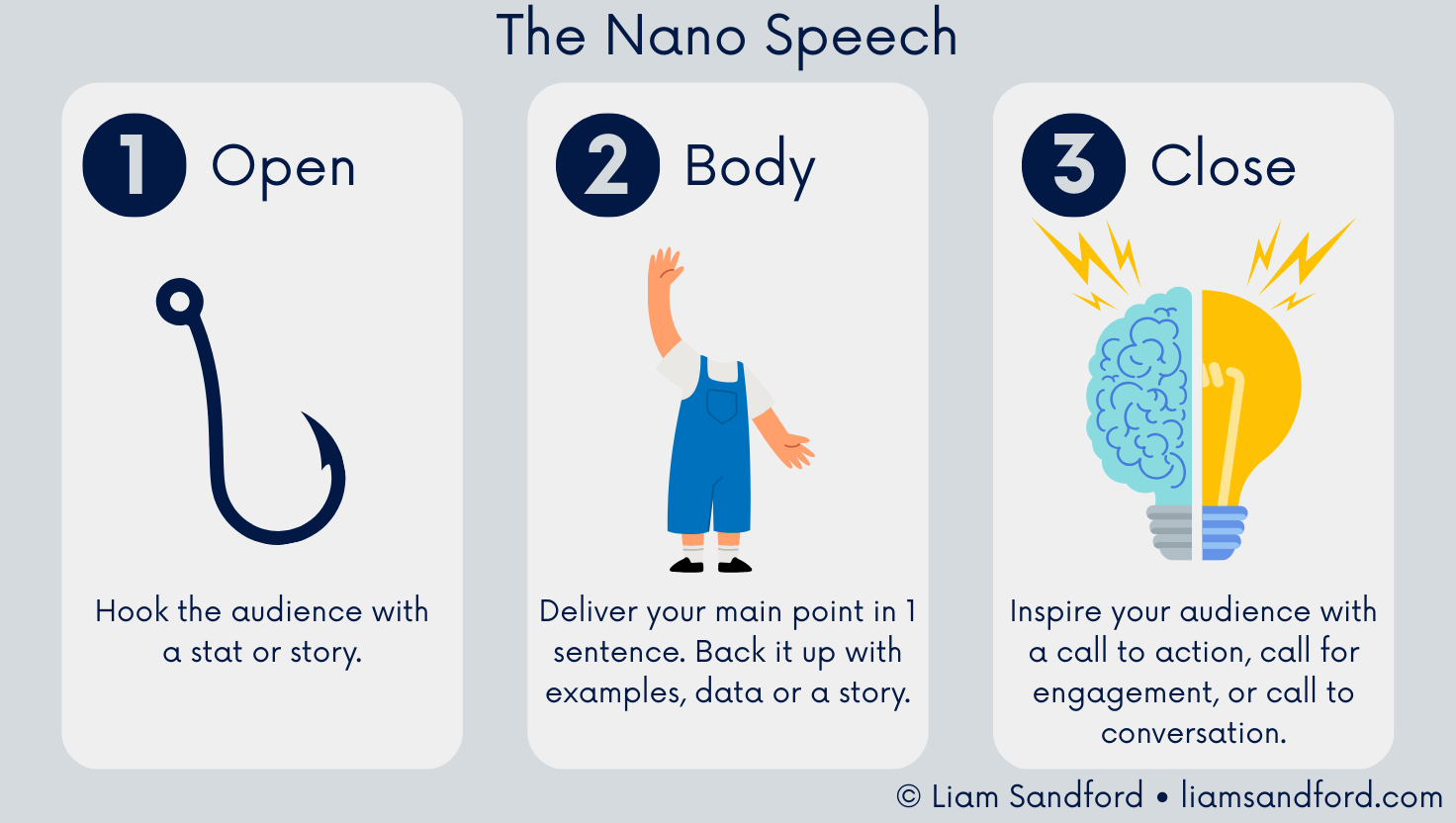Public Speaking vs Presentation Skills: Why They Are One and the Same

Liam Sandford
Liam Sandford is a public speaking coach, marketing leader, and 2x Best Selling Author, including the book Effortless Public Speaking. He helps introverted professionals and leaders take control of public speaking anxiety and use speaking to market themselves, build influence, and communicate with impact.
Public Speaking and Presentation Skills are often thought of as two separate identities even though they are one and the same. One conjures images of formal speeches, standing on stage, or delivering a TED style talk, while the other is associated with slides, graphs, and boardroom meetings. The reality, however, is that the foundations are the same, and mastering these principles will make you effective in any scenario. Whether you are speaking to an audience of thousands or having a small conversation with your team, the techniques of confident, engaging communication remain constant.
In fact, viewing these skills as separate can slow your growth as a communicator. People often spend years refining slides or worrying about stage presence without realizing that the core abilities, clarity, confidence, storytelling, and audience engagement, transfer everywhere. This guide breaks this down for you.
What Is Public Speaking?
Public speaking typically refers to delivering a prepared message to an audience. It often occurs in formal settings such as conferences, auditoriums, or lectures. The emphasis is on projecting confidence, clarity, and authority, and it usually does not rely on slides or visual aids. The audience primarily listens and absorbs the content, with limited interaction or input during the delivery. But honestly, public speaking can just be a conversation without the pressure cooker environment. This is something you can learn more about in the Ultimate Guide to Public Speaking.
What Is Presentation Skills?
Presentation skills is thought of as having visual aids such as slides and typically refers to speaking in a workplace, classroom or a conference setting. While the content may still be structured and rehearsed, presenters often adapt their message in real time based on audience reactions, engagement, or feedback. Honestly, while it is thought of as different, presentation skills and public speaking is the same thing, and ultimately in its most basic form, it’s just like having a conversation.
Public Speaking Can Happen Anywhere
The truth is that public speaking occurs in many settings, not just on formal stages. You can practice public speaking while leading a team meeting, participating in a panel discussion, hosting a webinar, or even explaining a concept to friends or family. Everyday conversations often provide the perfect training ground, allowing you to refine voice modulation, storytelling, and timing. Recognizing these moments as opportunities to practice public speaking can accelerate skill development far more than waiting for formal events.
Slides Don’t Change the Fundamentals
Presentations often include slides or other visual aids, which can enhance understanding and engagement. But slides alone do not make a talk effective. Many people over rely on slides, using them as a crutch while neglecting core public speaking skills such as delivery, audience awareness, and storytelling. Even a slide heavy presentation requires preparation, structure, and confidence to succeed. The principles you use in any presentation, clear messaging, audience connection, and practiced delivery, are exactly the same principles used in stage any public speaking.
The Anxiety Factor Is the Same
Whether you’re speaking to a single colleague or hundreds of people, anxiety can affect performance. Many believe that presentations with slides are “safer” because they are usually used to provide prompts to the speaker (although this is a terrible approach and I don’t advocate for that), but slides do not remove nerves or guarantee engagement. Anxiety management, preparation, and mental rehearsal are essential in both cases. By recognizing that the same challenges apply to public speaking and presentations, you can approach all scenarios with consistent strategies, reducing fear and improving performance.
The Core Principles Are Identical
At the heart of both public speaking and presentations lie universal principles that transcend context. Learning these principles allows you to communicate effectively regardless of setting, tools, or audience size. Frameworks like the Nano Speech emphasize the same core elements: confidence, structure, storytelling, and delivery. Practicing these consistently ensures that your communication is impactful in every scenario.
Confidence and Mindset
Confidence is one of the most crucial elements of effective communication. It’s less about eliminating nerves and more about managing them effectively. A confident speaker commands attention, engages the audience, and conveys credibility. Preparation is the key, knowing your content, understanding your audience, and mentally rehearsing your talk can dramatically improve performance. Mindset is equally important, approaching every talk as an opportunity rather than a threat allows you to project calm authority. Confidence can be built in small, everyday interactions just as effectively as on stage.
Audience Awareness and Engagement
Successful communicators always prioritize their audience. Who are they? What do they care about? How can your message resonate with them? Adjusting content, tone, pacing, and body language in real time helps maintain attention and connection. Techniques like asking questions, making eye contact, and reading non-verbal cues are just as important in a boardroom presentation as they are in a public lecture. Audience centered communication ensures your message lands, regardless of format.
Structure and Storytelling
A clear structure is essential for retention and impact. The Nano Speech emphasizes three main elements: open body, and close. This framework is versatile and works for a 10 second conversation, a 30 minute workshop, or an hour long keynote. Storytelling enhances this structure by adding emotional context, real life examples, and memorable narratives. People remember stories far longer than they remember facts or slides. Incorporating anecdotes, case studies, or personal experiences increases relatability and engagement.
Voice, Pauses, and Body Language
Delivery can make or break your communication. Tone, pacing, gestures, and facial expressions reinforce your message and convey confidence. Strategic pauses allow your audience to process key points and emphasize important ideas. Purposeful movement and posture project authority and help maintain attention. These delivery elements are crucial in both formal speeches and everyday presentations, proving that slides or stage presence are secondary to the fundamentals of human connection.
How Slides Fit In And Why They Don’t Change the Foundations
Slides and visuals often create the perception that presentations require a unique skill set. While they can enhance understanding and retention, they do not replace the foundational principles of communication. Slides are tools, not substitutes for preparation, confidence, and structure.
When Visuals Help
Slides are most effective when they support your message rather than dominate it. Visuals can clarify complex ideas, highlight key data, provide context, and enhance storytelling. A well designed slide is made for the audience, not the speaker. Slides are not your prompt and you should never use them like one. Visuals are complementary but the strength of the talk still relies on delivery, engagement, and audience awareness.
When Visuals Distract
Slides can hinder communication if misused. Overloading slides with text, reading word for word, or relying on flashy transitions shifts focus away from the speaker. This can disengage the audience, reduce clarity, and dilute your impact. Slides should never replace preparation or audience connection, they are most effective when integrated thoughtfully.
Presentations Without Slides
Slide free presentations demonstrate that the core principles remain unchanged. Structured content, clear storytelling, confident delivery, and audience engagement are still essential. In fact, practicing slide free communication strengthens your public speaking skills, making you more adaptable, persuasive, and confident in any context.
Applying Public Speaking Principles Everywhere
One of the greatest advantages of mastering public speaking principles is their transferability. These skills are useful in formal presentations, casual conversations, and everything in between.
Everyday Conversations
Even brief interactions, like talking to colleagues, friends, or clients, can benefit from storytelling, pauses, and audience awareness. Using these techniques in casual settings allows you to practice naturally, refine delivery, and build confidence over time. Everyday conversations are opportunities to practice without the pressure. Using the Nano Speech will ensure that you are improving in ways that are relevant to any presentations that you have to deliver.
Team Meetings and Workshops
Structured messaging, clear objectives, and engagement techniques transform routine team updates or workshops into compelling experiences. Planning your communication with a hook, body, and close ensures clarity, while interactive elements and storytelling maintain attention. These techniques make meetings more memorable and actionable.
Panel Discussions and Elevator Pitches
These formats require brevity and precision. Confidence, clarity, and concise delivery are essential to leaving a strong impression. Panel discussions demand real time adjustments based on audience questions and co-speaker contributions, while elevator pitches require distilling a complex idea into a clear, compelling 30–60 second message. In both cases, foundational principles apply.
How to Master Public Speaking and Presentation Skills
Mastery comes from practicing foundational principles consistently across contexts. Slides, stage, or audience size should not dictate the skills you focus on.
Use the Nano Speech
The Nano Speech provides a repeatable structure for all communication: a clear hook, focused body, and memorable close. Applying this framework across casual and formal scenarios ensures clarity, engagement, and confidence.
Practice Anywhere
Rehearse in in every day conversations, especially if you have a fear of public speaking. This is the way to increase your confidence in environments that have no pressure, or that you are comfortable in. Getting comfortable using the nano speech is your quickest way to become a confident speaker as the framework helps you transition from a conversation through to a presentation. Consistent practice strengthens your confidence, delivery, and adaptability, making your communication natural and effortless.
Focus on Delivery
Voice, pacing, gestures, and eye contact amplify your message. Paying attention to these elements, even in short interactions, builds confidence and ensures your audience remembers what you say. Delivery is what transforms structured content into a compelling experience.
Frequently Asked Questions
Do I need slides to be a good speaker?
No. Slides can help clarify or support your message, but effective communication relies on structure, storytelling, and confident delivery. The slides themselves are secondary to audience connection and engagement.
Can I practice public speaking in casual conversations?
Absolutely. Everyday conversations provide excellent opportunities to apply the same principles used in formal presentations if you use the Nano Speech Framework. This way you are using the same structure in 10 second conversations to an hour long presentation. Practicing storytelling, clarity, and audience awareness in informal settings strengthens confidence and skills across all contexts.
TL;DR: Mastering Communication with the Nano Speech
Nano Speech Structure: Use a clear hook, focused body, and memorable close for all communication, formal or casual.
Practice Anywhere: Rehearse in everyday conversations to build confidence, delivery, and adaptability.
Focus on Delivery: Voice, pacing, gestures, and eye contact turn structured content into a compelling experience.
Slides Are Optional: Effective speaking relies on structure, storytelling, and presence. Slides are secondary.
Everyday Application: Apply the framework in casual interactions to strengthen skills for presentations of any length.
More From Liam Sandford
Read my book: Effortless Public Speaking. Learn how to speak confidently, reduce stress, and turn public speaking into your competitive advantage. These actionable public speaking tips will help you improve your presentation skills for any audience.
Join the free 5-day email course: Get daily lessons packed with practical strategies to deliver effective presentations and speak confidently. This course is designed to build your public speaking skills step by step. Sign up below:

